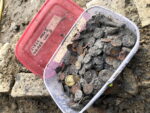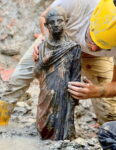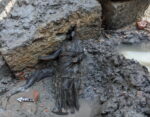 A group of 24 bronze statues in exceptional condition have been discovered in the excavation of the ancient sacred baths at San Casciano dei Bagni near Siena. They date to between the 2nd century B.C. and the 1st century A.D., making this the largest store of bronze statuary from ancient Italy ever found. It is so significant a find that it is comparable, according to Director General of Museums Massimo Osanna, to the sensational discovery of the pair of 5th century B.C. bronze warriors off the coast of Riace in 1972.
A group of 24 bronze statues in exceptional condition have been discovered in the excavation of the ancient sacred baths at San Casciano dei Bagni near Siena. They date to between the 2nd century B.C. and the 1st century A.D., making this the largest store of bronze statuary from ancient Italy ever found. It is so significant a find that it is comparable, according to Director General of Museums Massimo Osanna, to the sensational discovery of the pair of 5th century B.C. bronze warriors off the coast of Riace in 1972.
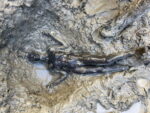 The hot springs and mineral waters of San Casciano dei Bagni were believed to cure all manner of illnesses and conditions via the intervention of deities versed in the medical arts, like Hygieia (goddess of health), Apollo (god of healing and diseases) and Asclepius (god of health). By bathing in the hot springs, the devout believed they were in direct contact with the gods. Those who could afford to, left figurines of bronze and terracotta representing an ailing body part, or offerings of shiny new coins struck at the sanctuary’s official mint. More than 6,000 coins have been recovered already.
The hot springs and mineral waters of San Casciano dei Bagni were believed to cure all manner of illnesses and conditions via the intervention of deities versed in the medical arts, like Hygieia (goddess of health), Apollo (god of healing and diseases) and Asclepius (god of health). By bathing in the hot springs, the devout believed they were in direct contact with the gods. Those who could afford to, left figurines of bronze and terracotta representing an ailing body part, or offerings of shiny new coins struck at the sanctuary’s official mint. More than 6,000 coins have been recovered already.
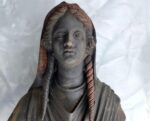 The Etruscans built the first sanctuary at the site at least as early as the 3rd century B.C. and it was expanded into a much larger complex by the Romans in the early 1st century. It was closed in the 5th century A.D. and the basins sealed with toppled columns. The effigies of the gods and votive figurines, left by generations of worshippers, however, were not disturbed.
The Etruscans built the first sanctuary at the site at least as early as the 3rd century B.C. and it was expanded into a much larger complex by the Romans in the early 1st century. It was closed in the 5th century A.D. and the basins sealed with toppled columns. The effigies of the gods and votive figurines, left by generations of worshippers, however, were not disturbed.
 Since excavations of the sanctuary began in 2019, archaeologists have found numerous votive offerings shaped like body parts (uteruses, penises, arms, legs, ears) that were left at the sacred site by petitioners seeking healing. Larger, whole-body statuary emerged from the pools in the first weeks of October. The hot, muddy basins preserved the metal, leaving many statues intact. Among the large statues are effigies of Hygieia, a snake wound around her arm, a nude of Apollo and a togate youth.
Since excavations of the sanctuary began in 2019, archaeologists have found numerous votive offerings shaped like body parts (uteruses, penises, arms, legs, ears) that were left at the sacred site by petitioners seeking healing. Larger, whole-body statuary emerged from the pools in the first weeks of October. The hot, muddy basins preserved the metal, leaving many statues intact. Among the large statues are effigies of Hygieia, a snake wound around her arm, a nude of Apollo and a togate youth.
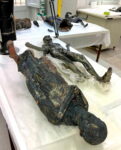 The discovery of two dozen bronze sculptures is so significant because most of them were destroyed in antiquity, melted down for reuse. They are also a unique record of the transition between the decline of Etruscan influence and the dominance of Rome. Etruscans, as with the other Italic peoples losing the battle (military, political and cultural conflicts with Rome , assimilated Roman culture and adopted Roman lifestyles. The statues illustrate this transitional period in their design style and in the inscriptions that were carved onto the bronzes in both Latin and Etruscan. The inscriptions contain the names of members of powerful Etruscan families like the Velimna of Perugia and the Marcni outside Siena who dedicated statues to the sacred pools.
The discovery of two dozen bronze sculptures is so significant because most of them were destroyed in antiquity, melted down for reuse. They are also a unique record of the transition between the decline of Etruscan influence and the dominance of Rome. Etruscans, as with the other Italic peoples losing the battle (military, political and cultural conflicts with Rome , assimilated Roman culture and adopted Roman lifestyles. The statues illustrate this transitional period in their design style and in the inscriptions that were carved onto the bronzes in both Latin and Etruscan. The inscriptions contain the names of members of powerful Etruscan families like the Velimna of Perugia and the Marcni outside Siena who dedicated statues to the sacred pools.
The town of San Casciano has big plans for this unique sanctuary. It will be converted into an archaeological park, and the 16th century palace overlooking the pools will become a museum exhibiting the thousands of archaeological treasures recovered from the site.
